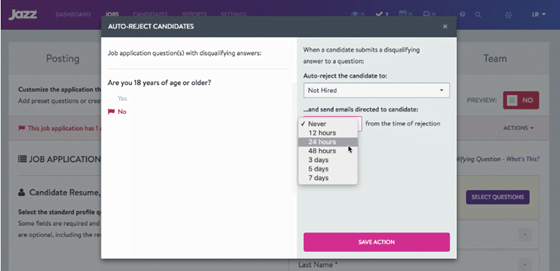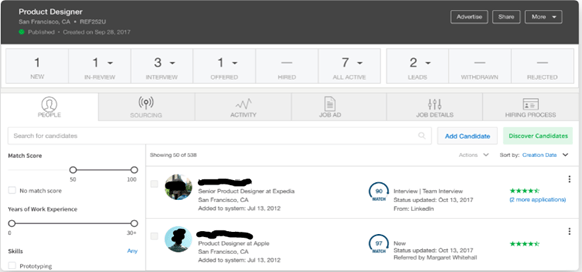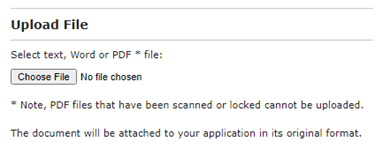Table of Contents
Job search has come a long way since the introduction of Applicant Tracking Systems (ATS). Gone were the days when jobs were advertised on bulletin boards, and newspapers and resumes were faxed or mailed by post. Most jobs are now advertised through online job platforms such as LinkedIn, Glassdoor, Indeed, and company career websites.
According to Forbes, 7.4 million job listings were posted online early this year. So, if you’re currently on a job hunt, you must be prepared to face both ATS and human decision-makers to maximize your application outcome. This starts with having the right information about how ATS works. In this article, we will demystify some of the common ATS myths you may have heard or read.
1) Improper formatting will cause your resume to get rejected
Tables, columns, and images don’t work well with some ATS. Nonetheless, this does not mean your application will automatically be thrown into the trash bin. Your application is still likely to go through. ATS will then convert your document into a text format for search purposes. As a result, your resume may lose its original formatting, distort the content, and make some of the keywords unsearchable. Such a presentation may lessen your application’s chances of getting interested by recruiters.
When dealing with ATS, going with a less is a more approach. Leave out the fancy formats and keep things simple. This will help ensure that your application is read and processed correctly. Here are some of the things you need to keep in mind.
- Stick with sleek, minimalist resume template designs.
- Avoid using tables, columns, and images.
- Utilize ATS-friendly fonts such as Arial, Times New Roman, Calibri, Cambria, and Helvetica.
2) Most online applicants don’t get interviews because of ATS
You have probably heard that most online job applications never get seen by humans. Sounds concerning, right? Here is the truth. While ATS make the recruitment process more efficient, they are not programmed to decide which applications get the chance to make it to the recruiters. Rather, ATS provides the necessary data that enable recruiters and hiring managers to make actionable decisions.
The only time you may be eliminated early in the hiring process is based on knock-out questions. These are questions that are typically asked to weed out candidates who lack required qualifications or are unable to perform key job functions. Common knock-out questions include the right to work, willingness to travel or relocate, and license requirements. Below is an example of what the knock-out question settings look like for recruiters who use JazzHR as their ATS.

Jazz HR ATS
In most cases, your resume will pass through the ATS and will be reviewed by human decision-makers. If you get a ‘thanks but no thanks’ response to your application, ATS is not necessarily the culprit. It’s more likely that a human had eyes on your application and decided not to move forward. This is either because the company’s needs have changed, you’re not a great fit, or there are stronger candidates for the job.
3) The more keywords, the better for ATS
Recruiters use keywords to filter relevant candidates. To make the screening process more efficient, some ATS is programmed to assign a score on applications based on keyword match. iCIMs, SmartRecruiters, and Jobvite are some of the common ATS that utilize a match score feature to filter top applicants. Generally, candidates with high scores are considered to be a good match.
The image below is an example of what scoring looks like for recruiters who use SmartRecruiters for their hiring needs. Does this mean the more keywords, the higher chances of winning an interview? This is not always the case. While keywords are important, quality matters over quantity.

SmartRecruiters ATS
What we mean by quality is including as many keywords as possible while ensuring content remains meaningful. Then, back them up with relevant duties and accomplishments. Don’t fall into the trap of keyword jamming or tricking the ATS. This will do more harm than good for your application. Remember, your main target audience is a human decision-maker, not the ATS.
4) Resume length makes a difference with ATS
Generally, ATS doesn’t have a standard length requirement for your resume to be read and processed correctly. On the contrary, longer resumes may score better for some ATS that utilize a match rate feature to screen applicants. Why? Because it’s easier to meet the required keyword volume with a longer document. But like what we mentioned above, more content does not necessarily equate to a better application outcome.
While length won’t hurt your chances of passing through ATS, you need to be careful with the length. Remember that an actual person will eventually review your resume. So, keeping the content as concise as possible while still conveying your worth is imperative. Human decision-makers prefer content that is focused and easy to read.
Here’s the recommended length based on location.
- North America – one to two pages
- Europe – two pages
- The Middle East – two pages
- New Zealand and Australia – two to three pages
- Rest of the World – one to two pages
From an experience perspective, we recommend the following.
- Junior professionals – one page
- Mid-career and late-career professionals – two pages
5) ATS only accepts Word format
ATS typically accepts documents in various formats. For example, Workable accepts file types in .pdf, .doc, .docx, .rtf, .html, and .odt. In most cases, company career pages will indicate what files are acceptable. So, you don’t have to do the guesswork of thinking about whether your document is compatible or not. For a company that uses Jobvite, here is what it looks like.

JobVite ATS
When you upload a non-compatible document, you will generally get an error message. This will prevent you from proceeding with the next steps of the online application process. Before uploading your resume, make sure you’re using one of the recommended file types. To be on the safe side, we highly suggest sticking with Word format as this is known to work well with most ATS.
When you research ATS online, you’ll see a lot of information. Some of them can be misleading, making candidates feel like ATS is an enemy that’s difficult to battle. This is not necessarily true. ATS can work to your advantage if you know the facts and follow best practices.


